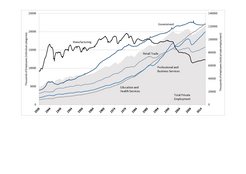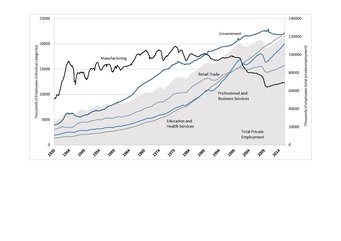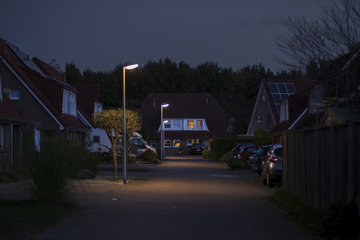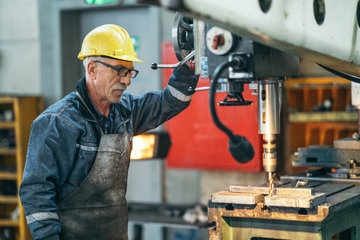Deindustrialization as fact and fiction
It is controversial whether there is or should be a fundamental change from an industrial to a service society in rich Western nations
The declining importance of manufacturing in rich societies is associated with deep concerns, but also with the hope of opening up new opportunities for economic development. As a result, predictions of a structural change from an industrial to a service society have repeatedly been the subject of political conflicts. To understand how social power structures and conflicts influence such future scenarios, it is important to look at the history of how and by whom post-industrial society has been framed in public debates.

Text: Timur Ergen, Max Planck Institute for the Study of Societies
It is an old-standing diagnosis: ever since the late 1970s, the industrial production of goods in affluent countries has been regarded as a discontinued model. According to strong versions of the narrative, in prosperous industrialized countries anything that is not outsourced to countries with cheaper labour costs will be automated piecemeal until, slowly but surely, a post-industrial society emerges. In the early 21st century, many social scientists associate deindustrialization, i.e., the declining social and economic relevance of manufacturing industry, with numerous social problems such as growing right-wing populism in the UK and the USA, widening interregional disparities, increasing income inequalities, declining productivity development, and political blockades in relation to climate policy. In one way or another, deindustrialization and its damaging effects represents a crucial cause of most challenges currently being discussed as imminent threats to the stability of democratic-capitalist societies.
Before increasingly being described as the scourge of affluent capitalist democracies since 2008, economic structural change had had a thoroughly positive connotation, even having been seen as a kind of post-capitalist utopia. In historical terms, the idea of a quasi-automatic structural change from manual field work to automotive engineering to software programming, is characterized by a belief in progress that is, from our current perspective, simply naïve. Historian Jan-Otmar Hesse has rightly described it as a last “dinosaur of the mesozoic of modernization theory.” The concept was often associated with promises that the decline of industry would help overcome class conflict, resource scarcity, and manual labour.
»Deindustrialization is associated with numerous social problems in the the early 21st century.«
The fact that structural change was associated with such profound hopes and fears has made it a highly politically contested scenario for the future. There has hardly been any trade conflict since the 1970s in which the respective industry under threat has not tried to declare itself indispensable with reference to the “future of domestic manufacturing.” And in just about every major economic policy reform, advocates have waxed lyrical about the blessings of “modern” industries set to take off in the near future.
Doom and gloom narratives and promises of renewal centred on the concept of deindustrialization are an expression of social conflicts concerning visions of the future. The reciprocal interplay between different interpretations of actual experiences, scientific observations, and political-economic conflicts over the definition of post-industrial society is typical for the way in which democratic capitalist societies confront their futures.
Deindustrialization as a fact

Data source: U.S. Bureau of Labor Statistics
The theory of structural change has been the subject of much scientific criticism. To mention just a few of the frequently repeated points of criticism: historically, many countries did not follow the three-step model. For example, they experienced a long period in which the agricultural sector dominated employment (Japan), a surplus in service employment during the period of peak industrialization (USA), or a surprisingly stable level of industrial employment in recent decades (Germany). What is more, the sectoral classification of economic activities is notoriously problematic. Far from being an empirical description of economic reality, the three-sector model is a highly abstract interpretive framework that nearly always leaves something to be desired on closer inspection. In which category does the accounting department of a turbine manufacturer belong?
And even if it is halfway possible to categorize certain activities conclusively, the fact remains that economic activities are functionally intertwined. One only has to consider the many activities that are interwoven with current-day agriculture, most of which do not take place on a farm. How are complex interlinkages between tasks and organizations taken into account when sorting activities into sectors? These and numerous other considerations have led many scientists to doubt the existence of simple patterns of post-industrial change.
Since the late 1990s, a common approach in the social sciences has been to acknowledge deindustrialization as a slow but steady relative decline in the importance of manufacturing in terms of employment and added value, largely due to changes in consumption patterns, globalization, and productivity gains in manufacturing in the OECD member states (and very recently in poorer countries). According to this interpretation – which often overlooks the experience of rapid shock therapy in post-socialist transitions –, many of the diagnoses of a rapid demise of manufacturing industry in affluent countries are overblown. The history of capitalism is characterized by ups and downs in the fortunes of specific companies, clusters, industries, and regions, in the 19th, 20th, and 21st centuries. The North East of England, the American Midwest, and the German Ruhr Valley are not the first regions in the history of capitalism that have had to contend with a rapid decline in their local sources of prosperity. According to the much-cited sceptical argument, in the mid-term, capital displacements between and within economic sectors should not be confused with path-breaking structural changes.
Deindustrialization as fiction
Yet arguments about the deep structure of the phenomenon are only of limited use for the sociological analysis of social reactions to deindustrialization. To the extent that corporate outsourcing occurred in geographically and historically “clustered” ways and was perceived by stakeholders as a structural rupture, such interpretations were meaningful and informed the relevant actions – even if they might have been “objectively wrong.” In other words: when tens of thousands of jobs were lost within a few years in regions, such as the Ruhr Valley or the steel clusters in Ohio, deindustrialization was naturally experienced as a drastic rupture. Such ruptures often formed social environments for interpretations of the future of industrial societies and shaped political-economic conflicts.
By tracing the trajectory of post-industrial change as a socially constituted concept of the future it is possible to gain insight into the dynamics of the formation of expectations in society. Conflicts over US corporate tax policy in the 1980s exemplify the associated dynamics. In 1981 Ronald Reagan’s administration passed the largest tax cut in American history – the Economic Recovery Tax Act , primarily with the stated goal to encourage struggling manufacturing industries to reinvest. Besides its obscene magnitude, the most remarkable thing about the tax cut was that it received broad bipartisan support in the US Congress. While a wide range of social groups were united by the desire to stabilize the industrial heartland in the turbulent early 1980s, but this alliance dissolved in the following years. In 1986 policy-makers ended the preferential treatment of capital-intensive enterprises in corporate tax policy, which had been common throughout in OECD member states since the Second World War, thereby openly turning against powerful manufacturing interests. This departure was driven by a new kind of alliance between small businesses, commerce, and states with a sparse industrial population, as well as experts who portrayed American society as being captured by outdated industrial structures. Based on this alliance, deindustrialization was transformed from being a unifying collective threat to a promise enabling the creation of new social coalitions.
At the same time, trade union representatives emphatically warned policy-makers that the USA would degenerate into a “nation of hamburger stands” – a rhetorical figure of speech that in German public discourse found its counterpart in the warning that “We can’t all become hair cutters.” Fighting off such warnings of industrial decline, Ronald Reagan advocated a radical change in corporate tax law in 1986, promising that : “That old tired economy (…) has been swept aside by a young, powerful locomotive of progress carrying a trainload of new jobs, higher incomes, and opportunities.” Actually occurring structural changes in the American economy were largely irrelevant to the respective debates. Interpretations of the future were instead formed on the basis of grand promises and threats.
Many fields of economic policy are characterized by similar dynamics, in which shifting power structures and social alliances have been accompanied by differing interpretive paradigms. Ever since the 1970s, the conflict between the selective consolidation of “old” industries and the preferential treatment of “new” industries has been pervading not only tax policy, but also education policy, labour market policy, trade policy, research and technology policy, and competition policy.
»Ever since the 1970s, the conflict between the selective consolidation of “old” industries and the preferential treatment of “new” industries has been pervading numerous policy areas.«
During the past decade, social conflicts about the future of the manufacturing sector have once again become extremely relevant. Following the financial crisis of 2008, the influence of the state on the structural composition of economic growth models has increasingly been called into question in all affluent Western democracies. Does the state have the power to force the adaptation of industrial structures to technological change, and should it do so? To what extent should social resources be devoted to conserving existing industrial structures? And, to what extent is it necessary to create space for forging links with new sectors and spheres of activity? Such issues are also currently leading to social conflicts about models for the future.













